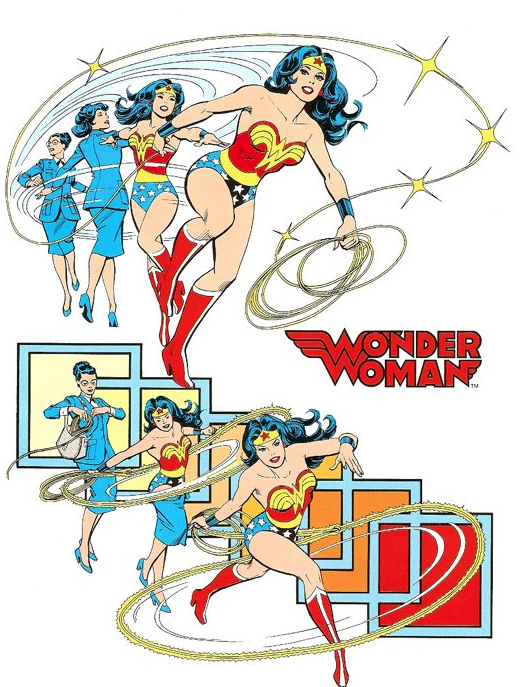How Superman Defeated the KKK (in Real Life): Hear the World-Changing 1946 Radio Drama
Earlier this week, we featured the 1950 Superman poster that urged students to defend the American way and fight discrimination everywhere. Today, we present another chapter from Superman’s little-known history as a Civil Rights defender.
The year is 1946. World War II has come to an end. And now membership in the Ku Klux Klan starts to rise again. Enter Stetson Kennedy, a human rights activist, who manages to infiltrate the KKK and then finds out an ingenious way to take them down. He contacts the producers of the popular Adventures of Superman radio show, and pitches them on a new storyline: Superman meets and defeats the KKK. Needing a new enemy to vanquish, the producers greenlight the idea.
The 16-episode series, “The Clan of the Fiery Cross,” aired in June, 1946 and effectively chipped away at the Klan’s mystique, gradually revealing their secret codewords and rituals. Listen to the episodes above. And take heart in knowing this: According to Stephen J. Dubner and Steven Levitt, the authors of Freakonomics, The Clan of the Fiery Cross was “the greatest single contributor to the weakening of the Ku Klux Klan.” Mocked and trivialized, the Klan’s numbers went back on the decline.
For more information on this chapter in superhero history, read the well-reviewed YA book, Superman Versus the Ku Klux Klan: The True Story of How the Iconic Superhero Battled the Men of Hate. Also find more information on these episodes at the Superman Homepage.
To hear more original Superman radio shows, head over to Archive.org.
Note: there is a little bit of a controversy about what exact role Stetson Kennedy played in infiltrating the Klan. You can read up on that here.
Thanks, Alissa, for calling this radio series to our attention.
If you would like to sign up for Open Culture’s free email newsletter, please find it here. Or follow our posts on Threads, Facebook, BlueSky or Mastodon.
If you would like to support the mission of Open Culture, consider making a donation to our site. It’s hard to rely 100% on ads, and your contributions will help us continue providing the best free cultural and educational materials to learners everywhere. You can contribute through PayPal, Patreon, and Venmo (@openculture). Thanks!
Related Content:
The Original 1940s Superman Cartoon: Watch 17 Classic Episodes Free Online
Read More...1950 Superman Poster Urged Kids to Defend All Americans, Regardless of Their Race, Religion or National Origin
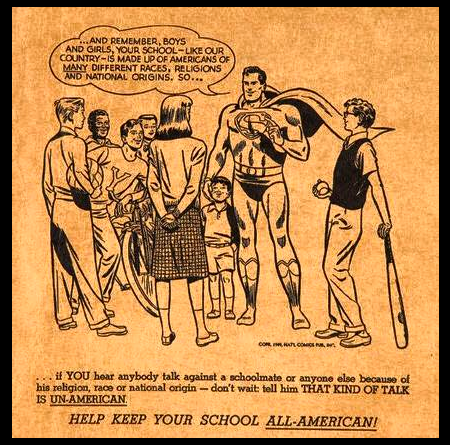
It makes sense that Superman would take a tolerant view of immigrants and other minorities, given that he himself arrived on Earth as a refugee from the planet Krypton.
The Man of Steel may strike you as an unlikely mouthpiece for progressive ideals, but 1950 found him on a book cover, above, engaged in conversation with a small crowd of mostly white boys:
“…and remember, boys and girls, your school – like our country – is made up of Americans of many different races, religions and national origins, so … If YOU hear anybody talk against a schoolmate or anyone else because of his religion, race or national origin – don’t wait: tell him THAT KIND OF TALK IS UN-AMERICAN. HELP KEEP YOUR SCHOOL ALL-AMERICAN!”
In other words, citizens must steel themselves to take action, because you can’t always count on a superhero to show up and make things right.
The cheap paper jacket, above, was distributed to school children by the Institute For American Democracy, an offshoot of the New York-based Anti-Defamation League.
(Perhaps President Elect was too young to receive a copy. The back of the cover includes a grid for filling in one’s class schedule and he was but four years old at the time.)
Superman could not survive Doomsday, but the Anti-Defamation League, planet Krptyon to the illustration’s original distributer, continues to uphold the values he promotes above.
Jonathan Greenblatt, the ADL’s CEO issued a post-Election statement that reads in part:
Already there have been troubling signs of a spike in hate crimes in the days after the election. As we look ahead, ADL will be vigilant against extremism and relentlessly hold the new administration accountable. You can expect ADL to be unwavering in its commitment to fighting anti-Semitism, racism and bigotry. We will monitor developments and speak out.
And wherever and whenever Jews, minority groups, immigrants, and others are marginalized or our civil liberties are threatened, ADL vigorously will defend those rights … We will not shrink from the fight ahead regardless of where it takes us.
In addition to maintaining a database of hate symbols and a form where citizens can report Anti-Semitic, racist, or bigoted encounters, the ADL has a robust list of educational resources for parents, teachers and youth.
Meanwhile, a full color version of the 66-year-old illustration has been making the rounds on social media. Let us consider it a placeholder. Eventually someone will surely take it back to the drawing board to add more girls, children with disabilities, and children of color.
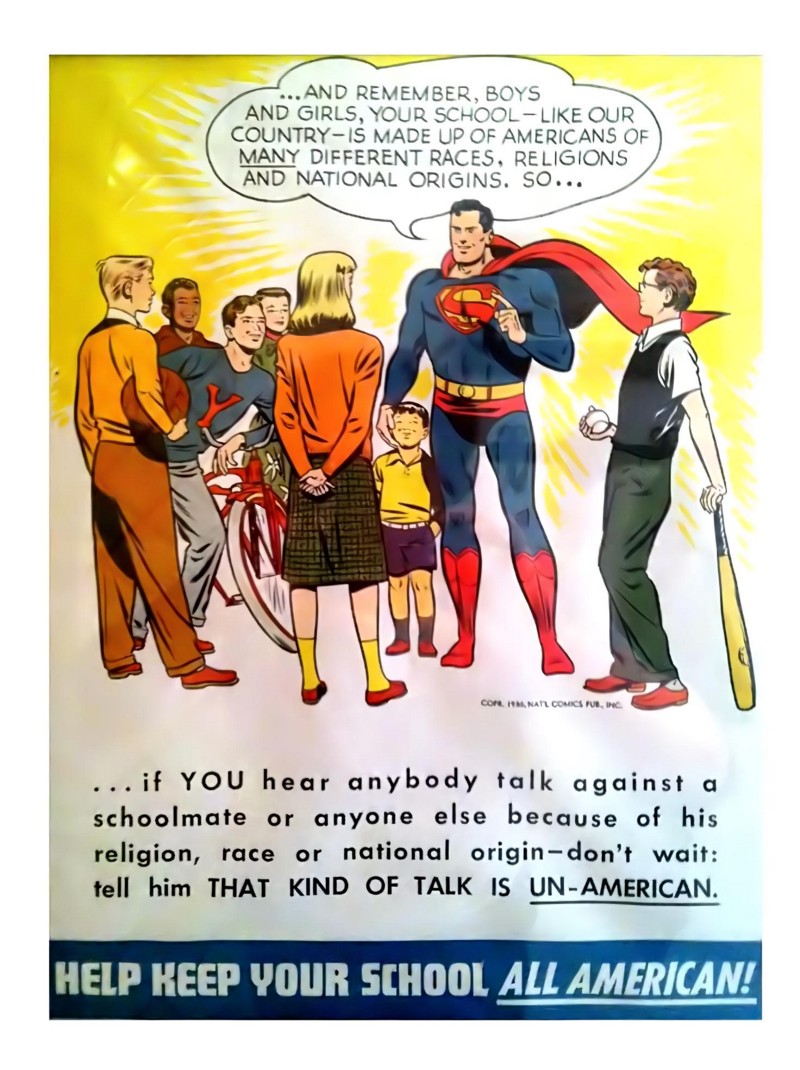
Related Content:
Batman Stars in an Unusual Cartoon Adaptation of Dostoyevsky’s Crime and Punishment
Dr. Seuss Draws Anti-Japanese Cartoons During WWII, Then Atones with Horton Hears a Who!
The Original 1940s Superman Cartoon: Watch 17 Classic Episodes Free Online
Ayun Halliday is an author, illustrator, theater maker and Chief Primatologist of the East Village Inky zine. Her play Zamboni Godot is opening in New York City in March 2017. Follow her @AyunHalliday.
Read More...Nietzsche’s Concept of Superman Explained with Monty Python-Style Animation
Friedrich Nietzsche first introduced the concept of the Übermensch — often translated in English as “The Superman” — in his influential philosophical work, Thus Spake Zarathustra (1883), writing:
I TEACH YOU THE SUPERMAN. Man is something that is to be surpassed. What have ye done to surpass man?
All beings hitherto have created something beyond themselves: and ye want to be the ebb of that great tide, and would rather go back to the beast than surpass man?…
Lo, I teach you the Superman!
The Superman is the meaning of the earth. Let your will say: The Superman SHALL BE the meaning of the earth!
I conjure you, my brethren, REMAIN TRUE TO THE EARTH, and believe not those who speak unto you of superearthly hopes! Poisoners are they, whether they know it or not.
Despisers of life are they, decaying ones and poisoned ones themselves, of whom the earth is weary: so away with them!
Once blasphemy against God was the greatest blasphemy; but God died, and therewith also those blasphemers. To blaspheme the earth is now the dreadfulest sin, and to rate the heart of the unknowable higher than the meaning of the earth!
As Eva Cybulska observes in an article on Philosophy Now, Nietzsche never quite spelled out what he meant by Übermensch/The Superman, leaving it to later interpreters to fill in the blanks. She notes: “RJ Hollingdale (in Nietzsche) saw in Übermensch a man who had organised the chaos within; [Walter] Kaufmann (Nietzsche) a symbol of a man that created his own values, and Carl Jung (Zarathustra’s Seminars) a new ‘God’. For Heidegger it represented humanity that surpassed itself, whilst for the Nazis it became an emblem of the master race.”
You can now add to the list of interpretations another by Alain de Botton’s School of Life. In a newly-released animated video, de Botton treats The Superman as the incarnation of human perfection. Embodying characteristics possessed by Goethe, Montaigne, Voltaire and Napoleon (people who came closest to achieving perfection in Nietzsche’s mind), the Übermenschen/Supermen will live by their own values (Pagan in nature); delight in their superiority and take pity on the weak; perhaps hurt people in the name of achieving great things; accept that suffering can be a necessary evil; use culture to raise the mentality of the society around them; and beyond.
Whether you see The Superman differently is another question. You can download Thus Spake Zarathustra from our Digital Nietzsche collection and come up with your own take.
And, tangentially, you can watch The Original 1940s Superman Cartoon Free Online.
Related Content:
Download 100 Free Philosophy Courses and Start Living the Examined Life
Free Online Philosophy Courses
The Digital Nietzsche: Download Nietzsche’s Major Works as Free eBooks
Hear Classical Music Composed by Friedrich Nietzsche: 43 Original Tracks
How Martin Luther King, Jr. Used Hegel, Kant & Nietzsche to Overturn Segregation in America
Read More...The 1982 DC Comics Style Guide Is Online: A Blueprint for Superman, Batman & Your Other Favorite Superheroes
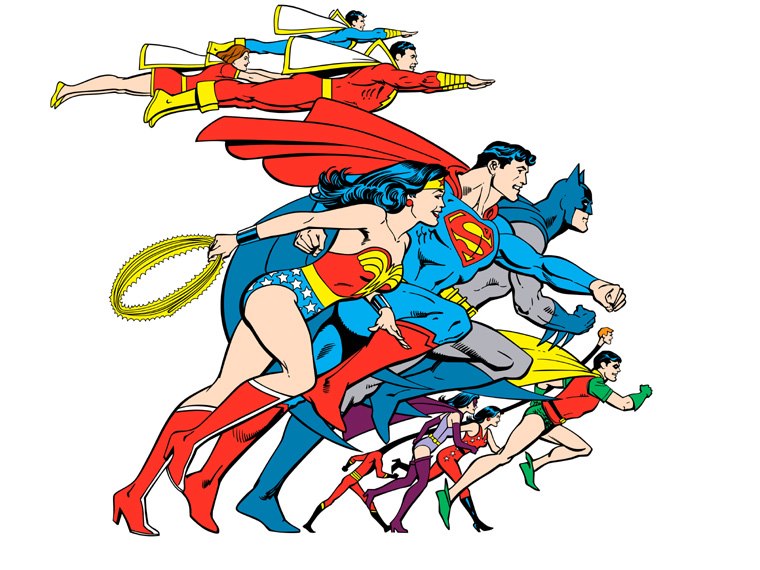
Even if you don’t like comic books, think of names like Superman, Batman, and Wonder Woman, and you get a very clear mental picture indeed. Classic superheroes live, breathe, battle supervillians, and even die and return to life across decades upon decades of storylines (and often more than one at once), but we all know them because, just like the most enduring corporate logos, they also stand as surpassingly effective works of commercial art. But given that countless different artists in various media have had to render these superheroes over those decades, how have their images remained so utterly consistent?

That owes to documents such as the 1982 DC Comics Style Guide, scanned and recently posted to a Facebook group for fans of comic-book artist José Luis García-López. Having spent most of his career with DC Comics, caretaker of Superman, Batman, Wonder Woman, and many other well-known and much-licensed heroes and villains besides, García-López surely knows in his very bones the sort of details of costume, physique, posture, and bearing these style guides exist to convey.
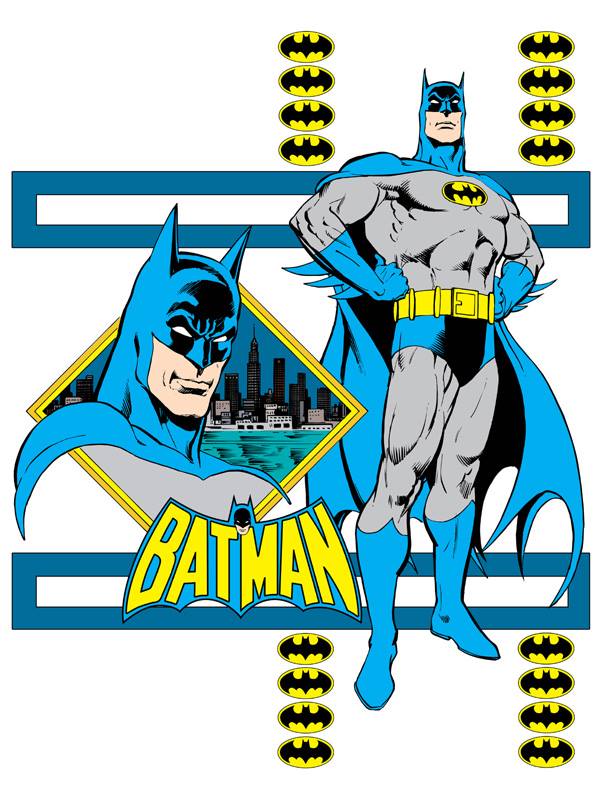
Being 33 years old, this particular style guide doesn’t perfectly reflect the way all of DC’s superheroes look today, what with the aesthetic changes made to keep them hip year on year. But you’ll notice that, while fashions tend to have their way with the more minor characters (longtime DC fans especially lament the headband and big hair this style guide inflicted upon Supergirl), the major ones still look, on the whole, pretty much the same. Sure, Superman has the strength and the flight, Batman has the wealth and the vast armory of high-tech crime-fighting tools, and Wonder Woman can do pretty much anything, but all those abilities pale in comparison to the sheer power of their design. You can flip through the rest of the Style Guide here.
(via Metafilter)
Related Content:
Download Over 22,000 Golden & Silver Age Comic Books from the Comic Book PlusArchive
Download 15,000+ Free Golden Age Comics from the Digital Comic Museum
Kapow! Stan Lee Is Co-Teaching a Free Comic Book MOOC, and You Can Enroll for Free
Batman & Other Super Friends Sit for 17th Century Flemish Style Portraits
Colin Marshall writes on cities, language, Asia, and men’s style. He’s at work on a book about Los Angeles, A Los Angeles Primer, and the video series The City in Cinema. Follow him on Twitter at @colinmarshall or on Facebook.
Read More...75 Years of Superman in 2 Minutes
As we told you this summer, Superman is celebrating his 75th Anniversary this year. And to help commemorate this milestone, “Man of Steel director Zack Snyder teamed up with artist and animator extraordinaire Bruce Timm to create a two-minute short that traces the Man of Steel’s history from Superman’s debut on the cover of 1938’s Action Comics #1 all the way to Henry Cavill in Man of Steel.” After you watch the video, you’ll want to head over to DC Comics, where they’ve created a long list of annotations that explain the sometimes subtle references in the short. You’ll also want to revisit our post where we featured Superman (or The Mad Scientist), the 1941 film that marked Superman’s first appearance on the big screen. Plus you can listen to the Adventures of Superman radio drama that aired between 1938 and 1951. Enjoy the tribute.
via Metafilter
Related Content:
The Mechanical Monsters: Seminal Superman Animated Film from 1941 (by Maria Popova)
Read More...The Original 1940s Superman Cartoon: Watch 17 Classic Episodes Free Online
On the eve of yet another Superman movie reboot—coming tomorrow with all the usual summer hit fanfare and noise—take a moment before gorging yourself on popcorn and extravagant CGI spectacles to reflect on the character’s enduringly simple origins. After all, this month marks the 75th anniversary of this most iconic of American superheroes, who first appeared in the June 1938 Action Comics #1. The brainchild of Cleveland high school students Jerry Siegel and Joe Shuster (so memorably fictionalized in Michael Chabon’s The Amazing Adventures of Kavalier & Clay), Superman is what Neil Gaiman calls an archetypal “primal thing,” a character who can be reinvented every decade while still remaining unmistakably himself.
Witness, for example, the first appearance of Superman on the big screen in the 1941 Fleischer cartoon (top), Superman (or The Mad Scientist)—the first in a series of seventeen shorts. On the heels of the first non-print adaptation of the character—the Adventures of Superman radio drama (listen below)—the cartoon series shows us the original Siegel and Shuster hero, a rough-and-tumble space alien raised in an orphanage, not by the kindly Kents in rural America.
You’ll notice however, that Superman’s resume—more powerful than a locomotive, able to leap tall buildings… etc.—hasn’t changed a bit. But some of the character’s attributes and origins were considerably softened after DC Comics editor Whitney Ellsworth instituted a code of superhero ethics (many years before the Comics Code Authority stepped in to censor the whole industry).
You can learn even more about Superman’s origins from his creators themselves, interviewed in the clip above for the 1981 BBC documentary Superman: The Comic Strip Hero. Siegel reveals how the idea for Superman came to him during one restless night in which he composed all of the basic script for the character, “an entirely new concept.” The very next day, Shuster sat down at his drawing board and Superman’s look emerged fully-formed. Both creators and their heirs have won and lost high-profile lawsuits over rights to their characters. But legal wrangling over compensation aside, there’s no denying that their mad eureka moment left an indelible cultural legacy no updated film, logo, or controversy can diminish.
Related Content:
Original Superman Cartoon Series Now Online
The Mechanical Monsters: Seminal Superman Animated Film from 1941
Josh Jones is a writer and musician based in Washington, DC. Follow him at @jdmagness
Read More...Nine Classic Superman Cartoons Restored and Now on YouTube
At the top of this post, you can watch 1941’s Superman, a short nominated for an Academy Award and (according to 1,000 animation professionals) the 33rd greatest cartoon of all time. When you’ve done that, how about eight more of the Man of Steel’s most aesthetically distinctive, pristinely restored animated adventures? Warner Brothers has just posted them, free for the watching, to their YouTube channel. They originally came out of Fleischer Studios, which animation buffs will know meant a true mark of quality back then. “Then,” in this case, means the early 1940s, and these Fleischer-produced Superman shorts brazenly bear the stylistic mark of that era. But if their rich, clean-lined look bursting with Technicolor strikes our eyes today as vintage, it also has a certain retro timelessness — if that doesn’t sound like too much of a contradiction in terms. No wonder they call this the Golden Age of Animation.
Just below, you’ll find Fleischer’s second Superman short, Mechanical Monsters, in which our hero battles exactly those. After it came Billion Dollar Limited, The Arctic Giant, The Bulleteers, The Magnetic Telecope, Electric Earthquake, Volcano, and Terror On The Midway and more— all within a span of under two years.
After 1942, Paramount handed the Superman contract to Famous Studios, which rose out of Fleischer’s dissolution. Eight additional shorts emerged, none now held in regard nearly as high as any of the Fleischer productions.
Where Fleischer possessed a surfeit of imagination, Famous seemed to suffer a deficit. (Their Second World War-themed Superman debut was titled Japoteurs.) But those first eight have enjoyed a long lifespan, particularly as high-profile influences. The Superman animated television series of the 1990s owes them a debt, as does even that same decade’s Batman series. Fans of Japanese animation will recognize the larcenous robots of Mechanical Monsters in Hayao Miyazaki’s series Lupin III and feature Castle in the Sky, and even the thoroughly irreverent Fox cartoon The Tick paid them homage. So, Hollywood types straining to dream up the next Superman franchise reboot: spend time with these still-entertaining, still-impressive pieces of animation, Hollywood cartoons like nothing Hollywood has put out since.
If you would like to sign up for Open Culture’s free email newsletter, please find it here. Or follow our posts on Threads, Facebook, BlueSky or Mastodon.
If you would like to support the mission of Open Culture, consider making a donation to our site. It’s hard to rely 100% on ads, and your contributions will help us continue providing the best free cultural and educational materials to learners everywhere. You can contribute through PayPal, Patreon, and Venmo (@openculture). Thanks!
via Cartoon Brew
Related content:
The Best Animated Films of All Time, According to Terry Gilliam
When Super Heroes Get Old and Retire to Miami
Free Vintage Cartoons: Bugs Bunny, Betty Boop and More
Colin Marshall hosts and produces Notebook on Cities and Culture. Follow him on Twitter at @colinmarshall.
Read More...The Mechanical Monsters: Seminal Superman Animated Film from 1941
In 1941, director Dave Fleischer and Paramount Pictures animators Steve Muffati and George Germanetti produced Superman: The Mechanical Monsters — a big-budget animated adaptation of the popular Superman comics of that period, in which a mad scientist unleashes robots to rob banks and loot museums, and Superman, naturally, saves the day. It was one of seventeen films that raised the bar for theatrical shorts and are even considered by some to have given rise to the entire Anime genre.
More than a mere treat of vintage animation, the film captures the era’s characteristic ambivalence in reconciling the need for progress with the fear of technology in a culture on the brink of incredible technological innovation. It was the dawn of the techno-paranoia that persisted through the 1970s, famously captured in the TV series Future Shock narrated by Orson Welles, and even through today. Take for example books like Nicholas Carr’s The Shallows and Sherry Turkle’s Alone Together: Why We Expect More from Technology and Less from Each Other.
Superman: The Mechanical Monsters is available for download on The Internet Archive, and Toonami Digital Arsenal has the complete series of all seventeen films. Find more vintage animation in Open Culture’s collection of Free Movies Online.
Maria Popova is the founder and editor in chief of Brain Pickings, a curated inventory of cross-disciplinary interestingness. She writes for Wired UK, The Atlantic and DesignObserver, and spends a great deal of time on Twitter.
Read More...Waiting for Superman (to Fix America’s Broken School System)
Davis Guggenheim, the Academy Award-winning director of An Inconvenient Truth, has issued a new clarion call for our times: Waiting for Superman, a new film that takes a hard look at America’s failing public education system, the children it’s leaving behind, and the reformers trying to turn things around. Above, you can watch the official trailer for the movie being released in select US theaters. And, right now, if you pledge to purchase a ticket, you can also direct a donation to a classroom of your choice.
Somewhere down the line (and ideally sooner than later), I hope that Guggenheim and Paramount Pictures will decide to make this film freely available to the public. It always struck me that the filmmakers limited the impact of An Inconvenient Truth by keeping it behind a pay wall. Hopefully, this time, they will recoup their money and give the film the freedom to spread an important message. There’s generally not a moral imperative to make films free. But, in this case, it seems a little different.
Note for education bloggers: The Huffington Post will be screening the film nationally, and they invite you to attend. Get details here.
Read More...Free Online: The Original Superman Cartoon Series in Technicolor (1941–1943)
Earlier this week, we flagged a digital archive of comic books from the Golden Age. Now we stumble upon this nugget from the same era: A video archive that showcases the complete Superman animated cartoon series from the early 40’s, all in Technicolor. Based on the original DC Comics character, these 17 episodes appeared on American movie screens (before the showing of feature films) between 1941 and 1943. And they were taken seriously as an art form. The first episode, commonly known as “The Mad Scientist” (watch above), was nominated for an Oscar in 1942, and, in case you somehow missed it, it spells out the whole premise/backstory of the Superman saga. These episodes – all now in the public domain – can be viewed on Youtube. Wikipedia provides some other options for watching/downloading these vintage bits of Americana media.
If you would like to sign up for Open Culture’s free email newsletter, please find it here. Or follow our posts on Threads, Facebook, BlueSky or Mastodon.
If you would like to support the mission of Open Culture, consider making a donation to our site. It’s hard to rely 100% on ads, and your contributions will help us continue providing the best free cultural and educational materials to learners everywhere. You can contribute through PayPal, Patreon, and Venmo (@openculture). Thanks!
Read More...